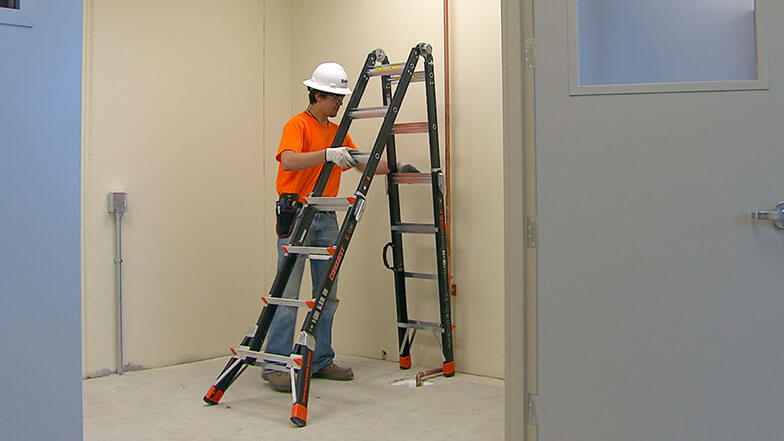
A contracted estimator fell from an extension ladder when a cracked rung broke while he was climbing the ladder. The estimator was seriously injured, sustaining a skull fracture and multiple leg fractures. The estimator had been aware of the defect in the ladder. The defect was caused when the ladder fell at an earlier job site. However, the estimator continued to use the ladder rather than seeking a replacement.
In another accident, a worker was seriously injured when he attempted to reach out and the ladder moved. Still another worker had a fatal fall from a ladder when he slipped while climbing and carrying materials.
Each accident involved an unsafe act and/or unsafe condition that safe ladder use would have prevented. Annually, in the construction industry, about 8 percent of all falls from elevation involve the use or misuse of ladders.
Although most accidents occur because a ladder is not used properly, other factors, such as use of defective ladders, improper setup or staging, and climbing or descending while carrying materials, contribute to serious injuries and substantial accident costs.
Annually, in the construction industry, about 8 percent of all falls from elevation involve the use or misuse of ladders.
Suggested Guidelines
(Before using these guidelines, please read the disclaimer at the end of this article.) To control accidents involving ladders, it is necessary to be aware of the basic guidelines for the selection, inspection, and use of ladders. Therefore, business in which ladders are used should consider adopting these or similar basic guidelines.
Selection
- Businesses should choose the proper ladder for the intended task. For example, if the ladder will be used near electrical sources, non-metallic ladders should be used to reduce the possibility of electrical shock. The manufacturer’s instructions also contain important guidelines for weight and height limitations.
- The construction of ladders should conform to the latest edition of the safety codes for portable wooden ladders (ANSI A14.1), portable metal ladders (ANSI A14.2), fixed ladders (ANSI A14.3), and job-made wooden ladders (ANSI A14.4).
- The supports on which a ladder rests, both top and bottom, should be rigid, capable of supporting the loads to be imposed, and such that lateral displacement cannot occur.
- All ladders should be of sufficient length so that workers will not stretch or assume a hazardous position.
Inspection
- Another crucial step is to always inspect the ladder before stepping on the first rung. Make sure it has been well maintained, that the rungs are clean, and all parts are intact. Never climb a slippery or shaky ladder.
- Broken or damaged ladders should be removed from service immediately and destroyed.
Use
- As with any tool or equipment, no employee should use a ladder without receiving training.
- The first step to using any ladder is to carefully read the instructions included in the manufacturer’s care and use booklet. The manufacturer’s instructions can help workers use ladders more safely.
- Setting up the ladder correctly will help prevent falls. When planting the base of any ladder, all feet of the ladder should be placed on a firm level surface, not on rocks, boards, or slopes. Spreaders on A-frame ladders should be completely open and locked before any weight is placed on the ladder.
- Ladders should not be placed in passageways, doorways, driveways, or any locations where they may be displaced by any other work unless protected by barricades or guards.
- When using an extension ladder, do not place the ladder at too extreme of an angle. A good rule is to allow 1′ of distance at the base for every 4′ of rise.
- To reduce potential strains, heavy, long extension ladders will usually require two people to carry and to set up. When the ladder is set in place, the base should be secured with ladder spikes or a wood board that is anchored to prevent movement.
- When a ladder extends over a roof edge, approximately 3′ of ladder should extend above the eaves to allow easy personnel access and egress. The ladder should be tied off at the roof edge by ropes or hooks to prevent the ladder from slipping. One person should hold the ladder stable while another climbs to tie off the ladder. It is also recommended that a person hold the ladder steady whenever another person is ascending or descending a ladder that cannot be tied off.
- Different types of ladders have different safety considerations, so be sure to check the manufacturer’s instructions for guidelines.
Guidelines to Help Prevent Ladder Tip-Over
Consider adopting these guidelines or similar ones as precautions that should be followed to help prevent a ladder from tipping over.
- Never carry equipment while climbing a ladder. Use a pulley to bring equipment up to work level.
- Always face the ladder when climbing; keep your body centered between both side rails.
- Never lean out while climbing or working on the ladder. Keep your weight evenly distributed.
- Never move a ladder while standing on it. Always make sure people and equipment are off the ladder before moving or closing the ladder.
Ladders, like any other tools, need to be maintained and used in accordance with manufacturer’s instructions. Following these or similar basic guidelines along with the manufacturer’s guidelines may help you to enjoy longer, safer use of ladders.
For more information, visit www.cna.com/riskcontrol or contact CNA Risk Control at RiskControl@cna.com.
MCAA thanks CNA for being a benefactor of MCAA2020, supplying the planning guide, and cosponsoring the dessert party.
The information, examples and suggestions presented in this material have been developed from sources believed to be reliable, but they should not be construed as legal or other professional advice. CNA accepts no responsibility for the accuracy or completeness of this material and recommends the consultation with competent legal counsel and/or other professional advisors before applying this material in any particular factual situations.


